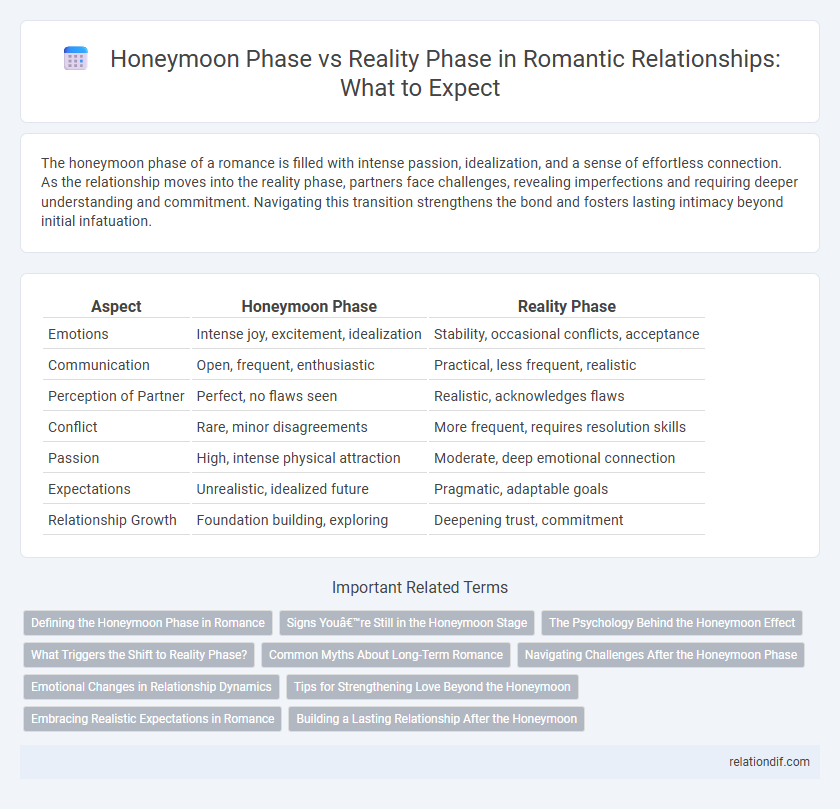The honeymoon phase of a romance is filled with intense passion, idealization, and a sense of effortless connection. As the relationship moves into the reality phase, partners face challenges, revealing imperfections and requiring deeper understanding and commitment. Navigating this transition strengthens the bond and fosters lasting intimacy beyond initial infatuation.
Table of Comparison
| Aspect | Honeymoon Phase | Reality Phase |
|---|---|---|
| Emotions | Intense joy, excitement, idealization | Stability, occasional conflicts, acceptance |
| Communication | Open, frequent, enthusiastic | Practical, less frequent, realistic |
| Perception of Partner | Perfect, no flaws seen | Realistic, acknowledges flaws |
| Conflict | Rare, minor disagreements | More frequent, requires resolution skills |
| Passion | High, intense physical attraction | Moderate, deep emotional connection |
| Expectations | Unrealistic, idealized future | Pragmatic, adaptable goals |
| Relationship Growth | Foundation building, exploring | Deepening trust, commitment |
Defining the Honeymoon Phase in Romance
The honeymoon phase in romance is characterized by intense passion, idealization, and emotional euphoria, typically lasting from a few months to about two years. During this period, partners experience heightened attraction and often overlook flaws, fostering a strong sense of connection and excitement. This initial stage contrasts sharply with the reality phase, where deeper understanding, challenges, and day-to-day dynamics shape the relationship's long-term trajectory.
Signs You’re Still in the Honeymoon Stage
Intense emotions, constant excitement, and idealization of your partner are key signs you're still in the honeymoon stage. Frequent displays of affection and minimal conflicts indicate the relationship's early euphoria. This phase often includes increased dopamine levels, fostering feelings of bliss and attachment.
The Psychology Behind the Honeymoon Effect
The psychology behind the honeymoon effect reveals that intense romantic attraction is driven by increased dopamine and oxytocin levels, creating feelings of euphoria and attachment. During the honeymoon phase, idealization of a partner and heightened emotional bonding mask potential conflicts or incompatibilities. As neurochemical levels stabilize in the reality phase, couples often face challenges requiring effective communication and emotional regulation to sustain long-term relationship satisfaction.
What Triggers the Shift to Reality Phase?
The shift from the honeymoon phase to the reality phase in a relationship is often triggered by the fading of initial infatuation and the emergence of everyday stresses and responsibilities. Couples begin to notice imperfections, differences in communication styles, and conflicting expectations that were previously overlooked. This transition reveals deeper compatibility issues and requires conscious effort to maintain emotional intimacy and trust.
Common Myths About Long-Term Romance
Many believe the honeymoon phase in romance lasts indefinitely, but studies show it typically fades within 6 to 12 months as oxytocin levels stabilize. Contrary to the myth that passion disappears, long-term couples often experience deeper emotional intimacy and commitment, supported by increased release of vasopressin and dopamine over time. Research in relationship psychology highlights that managing expectations and effective communication are key factors distinguishing enduring partnerships from those that falter post-honeymoon phase.
Navigating Challenges After the Honeymoon Phase
Navigating challenges after the honeymoon phase requires couples to develop effective communication skills and emotional resilience to manage everyday stressors and conflicts. Recognizing that the initial intensity of passion naturally evolves into deeper intimacy helps partners foster trust and mutual support during difficult times. Prioritizing shared goals and maintaining empathy are key strategies for sustaining long-term relationship satisfaction beyond the romantic idealism of the honeymoon period.
Emotional Changes in Relationship Dynamics
During the honeymoon phase, couples often experience intense euphoria and idealization, marked by heightened dopamine and oxytocin levels that foster deep emotional bonding and passion. As the relationship transitions into the reality phase, emotional dynamics shift toward stability and deeper attachment, accompanied by increased activation of brain regions linked to long-term bonding such as the ventral pallidum. This evolution reflects the natural progression from infatuation to mature love, where emotional fluctuations give way to trust, commitment, and the challenges of navigating everyday life together.
Tips for Strengthening Love Beyond the Honeymoon
Couples transitioning from the honeymoon phase to the reality phase benefit from open communication, expressing appreciation, and practicing empathy daily. Prioritizing shared goals and nurturing emotional intimacy through active listening fosters deeper connection. Consistent efforts in understanding each other's evolving needs strengthen love beyond initial passion.
Embracing Realistic Expectations in Romance
Embracing realistic expectations in romance allows couples to navigate the transition from the honeymoon phase to the reality phase with greater resilience and understanding. Recognizing that feelings of infatuation naturally evolve into deeper, more stable emotional connections fosters trust and effective communication. Couples who prioritize acceptance of imperfections and continuous growth often build stronger, long-lasting relationships.
Building a Lasting Relationship After the Honeymoon
The honeymoon phase often highlights intense passion and idealized perceptions, while the reality phase reveals challenges requiring deeper understanding and commitment. Building a lasting relationship after the honeymoon involves cultivating effective communication, mutual respect, and emotional resilience. Couples who prioritize trust, adaptability, and shared goals create a foundation that supports long-term intimacy and growth beyond initial infatuation.
honeymoon phase vs reality phase Infographic

 relationdif.com
relationdif.com